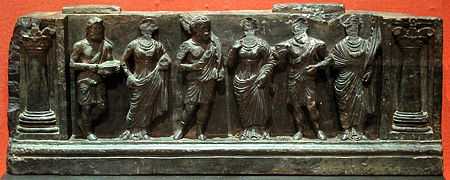Buner reliefs
The Buner reliefs are a series of frieze reliefs that lie in Buner District, from the area of the Peshawar valley in Pakistan. They are also near the Swat Valley.
Hellenistic scenes

Some of the reliefs depict people in Greek dress (the short tunic, or chiton, and the enveloping himation for women, and the short tunic, or exomis, for men) and poses, "often regaling each other with cups, and sometimes pouring from wineskins into cups or mixing bowls in the Greek manner" (Boardman). The characters are often represented alongside columns in the Corinthian style.
-
Left detail
-
Center detail
-
Right detail
-

A stair riser depicting an Ichthyo-Centaur, also considered as a Buner relief
Military scenes
Other reliefs, thought to be contemporary because of their identical style and structure, represent soldiers in military attire. They are depicted in ample tunics with trousers (the anaxyride), with a pointed hood and heavy straight sword as a weapon. With the right hand, some of them are forming the Karana mudra against evil spirits. In Gandhara, such friezes were used as decorations on the piedestals of Buddhist stupas. These soldiers could be Indo-Scythians, or possibly Phrygian troops from the Hellenistic realm.
Another relief is known where the same type of soldiers are dancing and playing musical instruments. The instruments are a small harp, a hand drum and a small portable xylophone. Three of the men are dancing, clasping both hands together.[1]
Indian scenes
Again other reliefs show people in Indian dress, typically holding lotus flowers.
All of these friezes, being contemporary with each other, hint at an intermixing of Indo-Scythians (holding military power), Indo-Greeks (confined, under Indo-Scythian rule, to civilian life, and usually shown revelling with drinking cups) and Indians (possibly most directly involved in religious matters, and shown with the reverencial lotus).
These reliefs usually belonged to Buddhist temples, where they were used as stair-risers, or thresholds to niches on Buddhist monuments. In addition to the Greek costumes depicted in them, the artwork of the reliefs is Hellenistic in style and content; they are considered some of the earliest examples of Greco-Buddhist art. They are usually dated to around the 1st century CE, although they might go back to the 1st century BCE, thus corresponding to the period of Indo-Greek and Indo-Scythian rule in the Indian subcontinent.
One of the most famous of these reliefs is the one located in the Victoria and Albert Museum.
References
- ↑ Original frieze in the Cleveland Museum of Art Cleveland Museum Buner relief collection
Resources
- John Boardman, The Diffusion of Classical Art in Antiquity (Princeton University Press, 1994) ISBN 0-691-03680-2
- Alexander the Great: East-West Cultural Contacts from Greece to Japan (NHK and Tokyo National Museum, 2003)
External links
| ||||||||||||||||||||||||||||||||||||||||||||||||||||||||


